Analysis of Total Reward System, Motivation, and Sector Comparison
VerifiedAdded on 2020/06/04
|11
|3359
|23
Report
AI Summary
This report provides a comprehensive overview of the total reward system within human resource management. It defines the concept of total rewards, encompassing financial and non-financial elements like salary, incentives, insurance, and work environment. The report links these aspects to motivation theories, exploring how compensation, benefits, and career opportunities influence employee engagement and performance. Furthermore, the report evaluates the effectiveness of the total reward system in two different employment sectors, specifically focusing on Marks and Spencer in the retail sector. It highlights how the system impacts employee engagement, retention, and the overall success of the business. The report concludes by summarizing the key findings and implications of implementing a comprehensive total reward system.
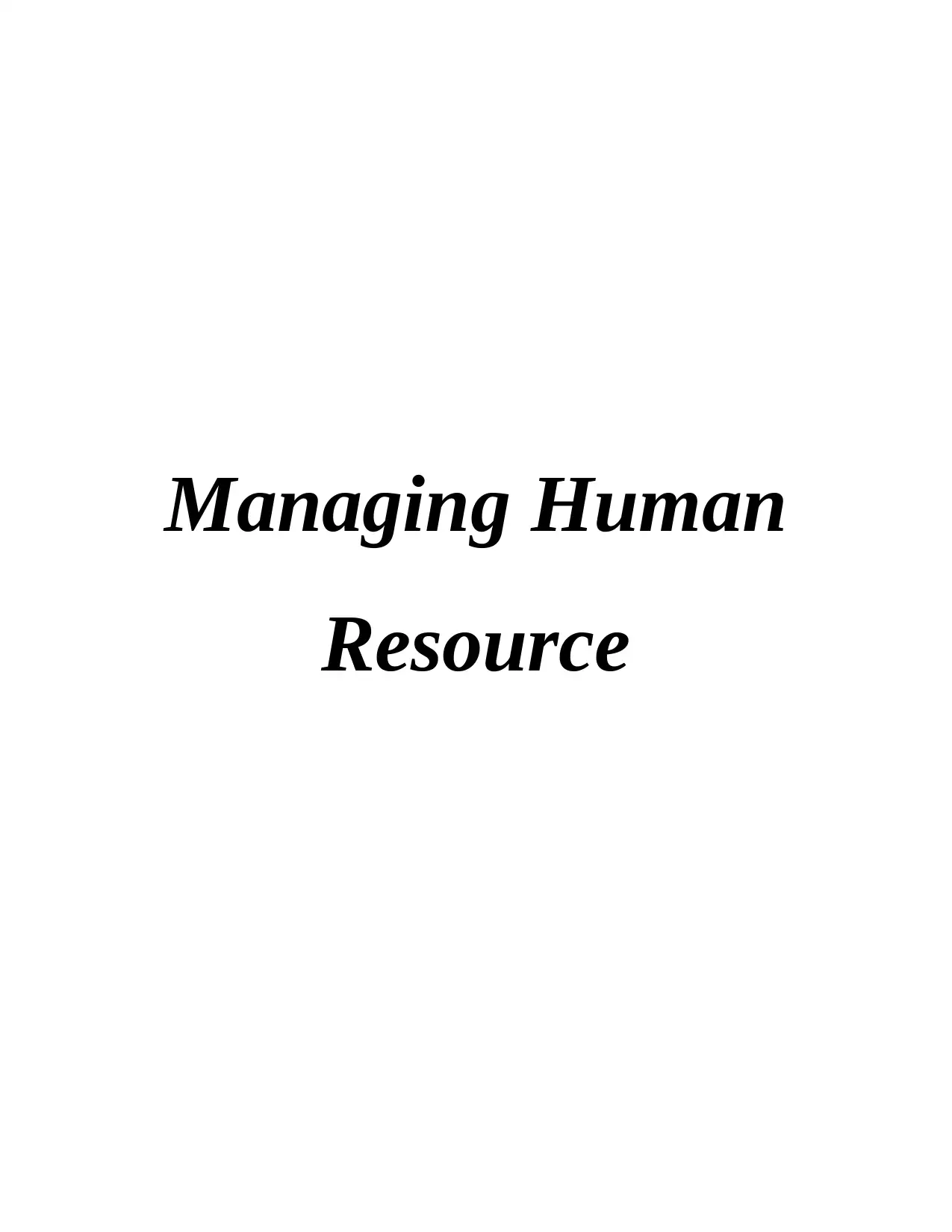
Managing Human
Resource
Resource
Paraphrase This Document
Need a fresh take? Get an instant paraphrase of this document with our AI Paraphraser
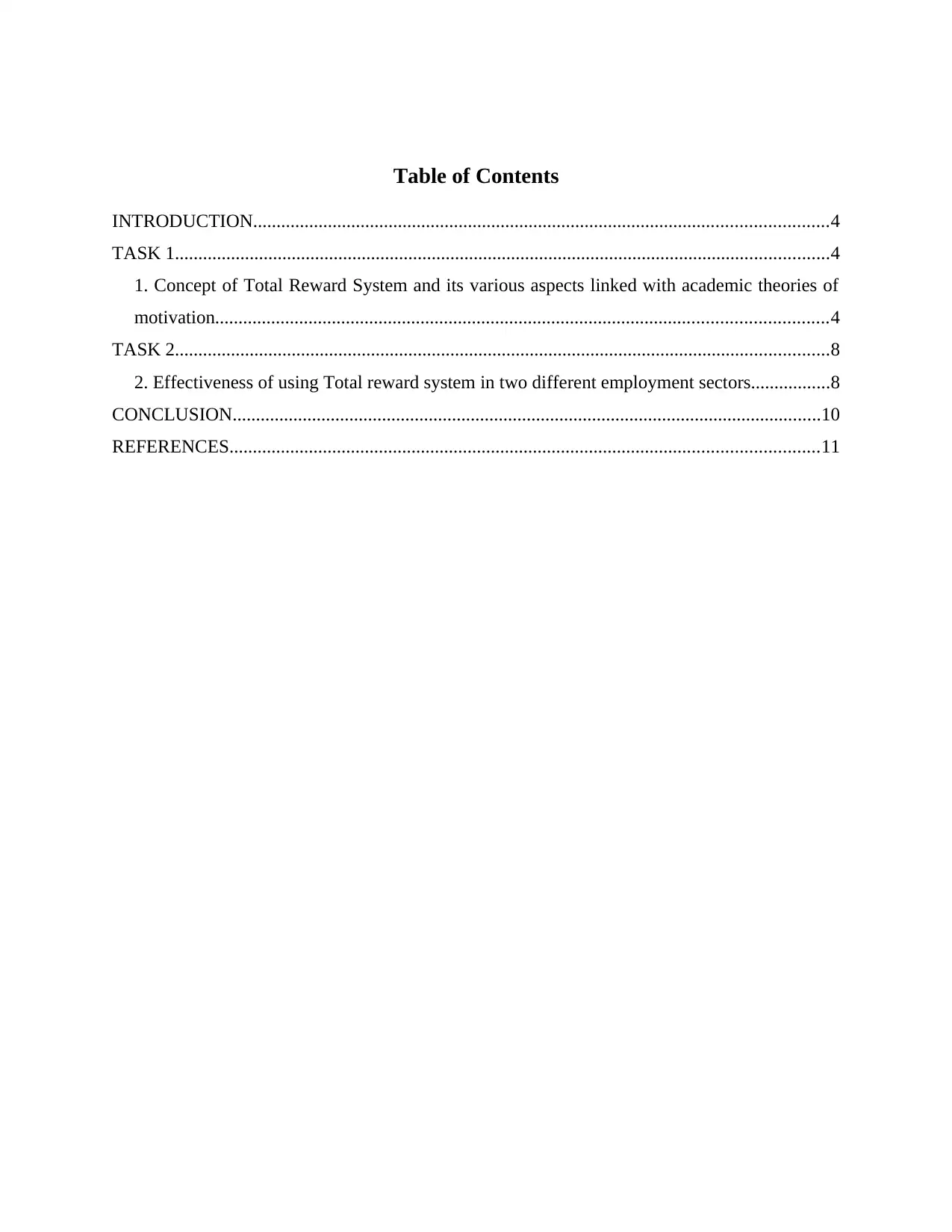
Table of Contents
INTRODUCTION...........................................................................................................................4
TASK 1............................................................................................................................................4
1. Concept of Total Reward System and its various aspects linked with academic theories of
motivation...................................................................................................................................4
TASK 2............................................................................................................................................8
2. Effectiveness of using Total reward system in two different employment sectors.................8
CONCLUSION..............................................................................................................................10
REFERENCES..............................................................................................................................11
INTRODUCTION...........................................................................................................................4
TASK 1............................................................................................................................................4
1. Concept of Total Reward System and its various aspects linked with academic theories of
motivation...................................................................................................................................4
TASK 2............................................................................................................................................8
2. Effectiveness of using Total reward system in two different employment sectors.................8
CONCLUSION..............................................................................................................................10
REFERENCES..............................................................................................................................11
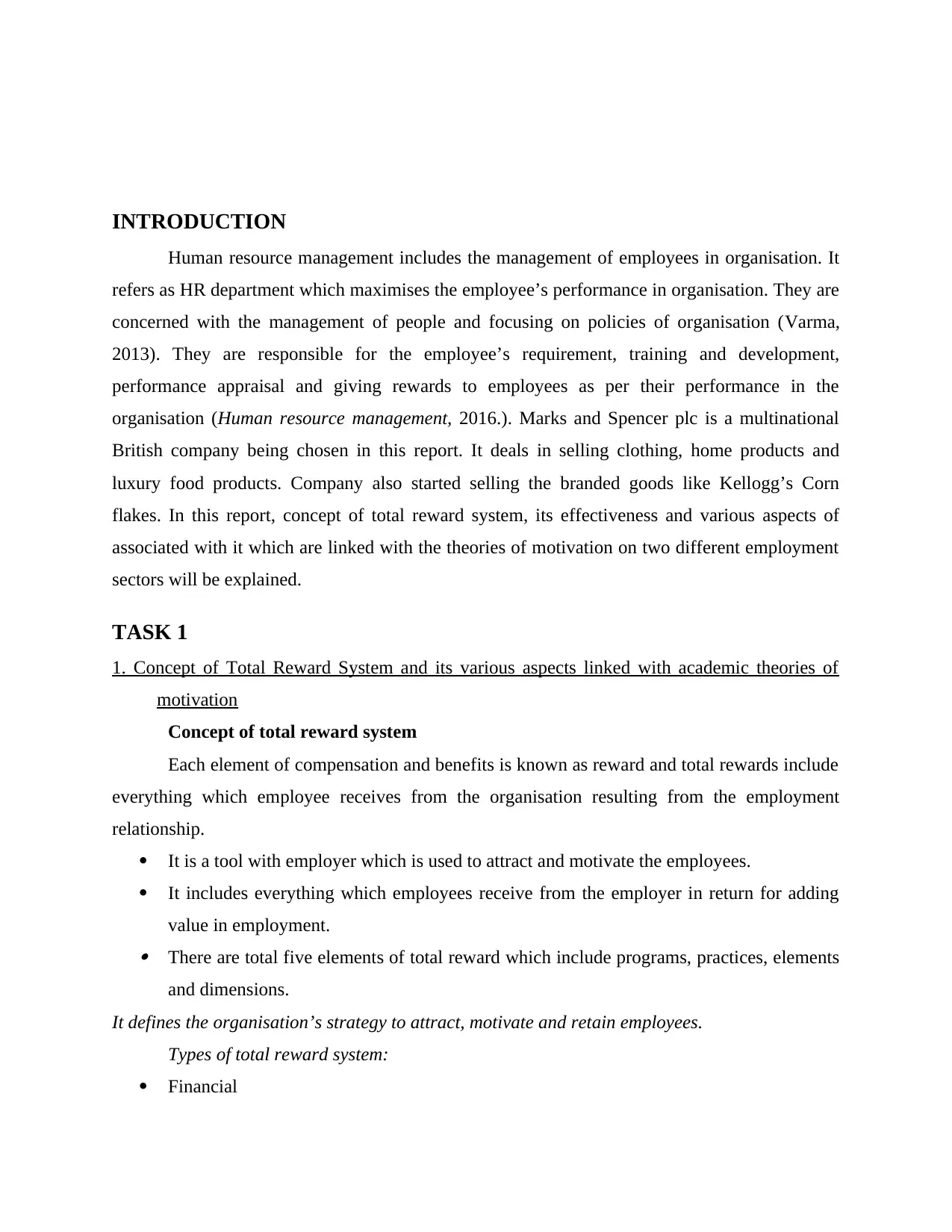
INTRODUCTION
Human resource management includes the management of employees in organisation. It
refers as HR department which maximises the employee’s performance in organisation. They are
concerned with the management of people and focusing on policies of organisation (Varma,
2013). They are responsible for the employee’s requirement, training and development,
performance appraisal and giving rewards to employees as per their performance in the
organisation (Human resource management, 2016.). Marks and Spencer plc is a multinational
British company being chosen in this report. It deals in selling clothing, home products and
luxury food products. Company also started selling the branded goods like Kellogg’s Corn
flakes. In this report, concept of total reward system, its effectiveness and various aspects of
associated with it which are linked with the theories of motivation on two different employment
sectors will be explained.
TASK 1
1. Concept of Total Reward System and its various aspects linked with academic theories of
motivation
Concept of total reward system
Each element of compensation and benefits is known as reward and total rewards include
everything which employee receives from the organisation resulting from the employment
relationship.
It is a tool with employer which is used to attract and motivate the employees.
It includes everything which employees receive from the employer in return for adding
value in employment. There are total five elements of total reward which include programs, practices, elements
and dimensions.
It defines the organisation’s strategy to attract, motivate and retain employees.
Types of total reward system:
Financial
Human resource management includes the management of employees in organisation. It
refers as HR department which maximises the employee’s performance in organisation. They are
concerned with the management of people and focusing on policies of organisation (Varma,
2013). They are responsible for the employee’s requirement, training and development,
performance appraisal and giving rewards to employees as per their performance in the
organisation (Human resource management, 2016.). Marks and Spencer plc is a multinational
British company being chosen in this report. It deals in selling clothing, home products and
luxury food products. Company also started selling the branded goods like Kellogg’s Corn
flakes. In this report, concept of total reward system, its effectiveness and various aspects of
associated with it which are linked with the theories of motivation on two different employment
sectors will be explained.
TASK 1
1. Concept of Total Reward System and its various aspects linked with academic theories of
motivation
Concept of total reward system
Each element of compensation and benefits is known as reward and total rewards include
everything which employee receives from the organisation resulting from the employment
relationship.
It is a tool with employer which is used to attract and motivate the employees.
It includes everything which employees receive from the employer in return for adding
value in employment. There are total five elements of total reward which include programs, practices, elements
and dimensions.
It defines the organisation’s strategy to attract, motivate and retain employees.
Types of total reward system:
Financial
⊘ This is a preview!⊘
Do you want full access?
Subscribe today to unlock all pages.

Trusted by 1+ million students worldwide
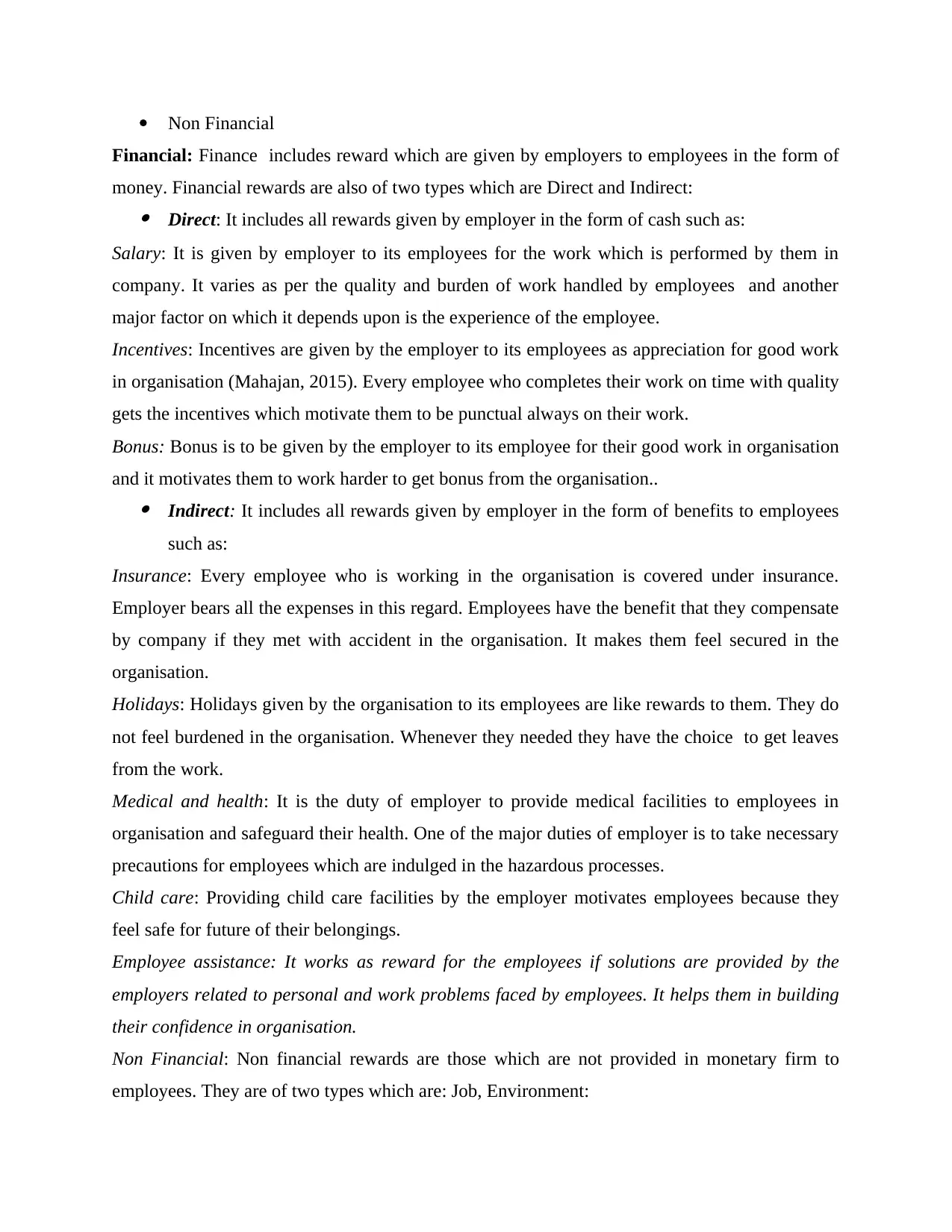
Non Financial
Financial: Finance includes reward which are given by employers to employees in the form of
money. Financial rewards are also of two types which are Direct and Indirect: Direct: It includes all rewards given by employer in the form of cash such as:
Salary: It is given by employer to its employees for the work which is performed by them in
company. It varies as per the quality and burden of work handled by employees and another
major factor on which it depends upon is the experience of the employee.
Incentives: Incentives are given by the employer to its employees as appreciation for good work
in organisation (Mahajan, 2015). Every employee who completes their work on time with quality
gets the incentives which motivate them to be punctual always on their work.
Bonus: Bonus is to be given by the employer to its employee for their good work in organisation
and it motivates them to work harder to get bonus from the organisation.. Indirect: It includes all rewards given by employer in the form of benefits to employees
such as:
Insurance: Every employee who is working in the organisation is covered under insurance.
Employer bears all the expenses in this regard. Employees have the benefit that they compensate
by company if they met with accident in the organisation. It makes them feel secured in the
organisation.
Holidays: Holidays given by the organisation to its employees are like rewards to them. They do
not feel burdened in the organisation. Whenever they needed they have the choice to get leaves
from the work.
Medical and health: It is the duty of employer to provide medical facilities to employees in
organisation and safeguard their health. One of the major duties of employer is to take necessary
precautions for employees which are indulged in the hazardous processes.
Child care: Providing child care facilities by the employer motivates employees because they
feel safe for future of their belongings.
Employee assistance: It works as reward for the employees if solutions are provided by the
employers related to personal and work problems faced by employees. It helps them in building
their confidence in organisation.
Non Financial: Non financial rewards are those which are not provided in monetary firm to
employees. They are of two types which are: Job, Environment:
Financial: Finance includes reward which are given by employers to employees in the form of
money. Financial rewards are also of two types which are Direct and Indirect: Direct: It includes all rewards given by employer in the form of cash such as:
Salary: It is given by employer to its employees for the work which is performed by them in
company. It varies as per the quality and burden of work handled by employees and another
major factor on which it depends upon is the experience of the employee.
Incentives: Incentives are given by the employer to its employees as appreciation for good work
in organisation (Mahajan, 2015). Every employee who completes their work on time with quality
gets the incentives which motivate them to be punctual always on their work.
Bonus: Bonus is to be given by the employer to its employee for their good work in organisation
and it motivates them to work harder to get bonus from the organisation.. Indirect: It includes all rewards given by employer in the form of benefits to employees
such as:
Insurance: Every employee who is working in the organisation is covered under insurance.
Employer bears all the expenses in this regard. Employees have the benefit that they compensate
by company if they met with accident in the organisation. It makes them feel secured in the
organisation.
Holidays: Holidays given by the organisation to its employees are like rewards to them. They do
not feel burdened in the organisation. Whenever they needed they have the choice to get leaves
from the work.
Medical and health: It is the duty of employer to provide medical facilities to employees in
organisation and safeguard their health. One of the major duties of employer is to take necessary
precautions for employees which are indulged in the hazardous processes.
Child care: Providing child care facilities by the employer motivates employees because they
feel safe for future of their belongings.
Employee assistance: It works as reward for the employees if solutions are provided by the
employers related to personal and work problems faced by employees. It helps them in building
their confidence in organisation.
Non Financial: Non financial rewards are those which are not provided in monetary firm to
employees. They are of two types which are: Job, Environment:
Paraphrase This Document
Need a fresh take? Get an instant paraphrase of this document with our AI Paraphraser
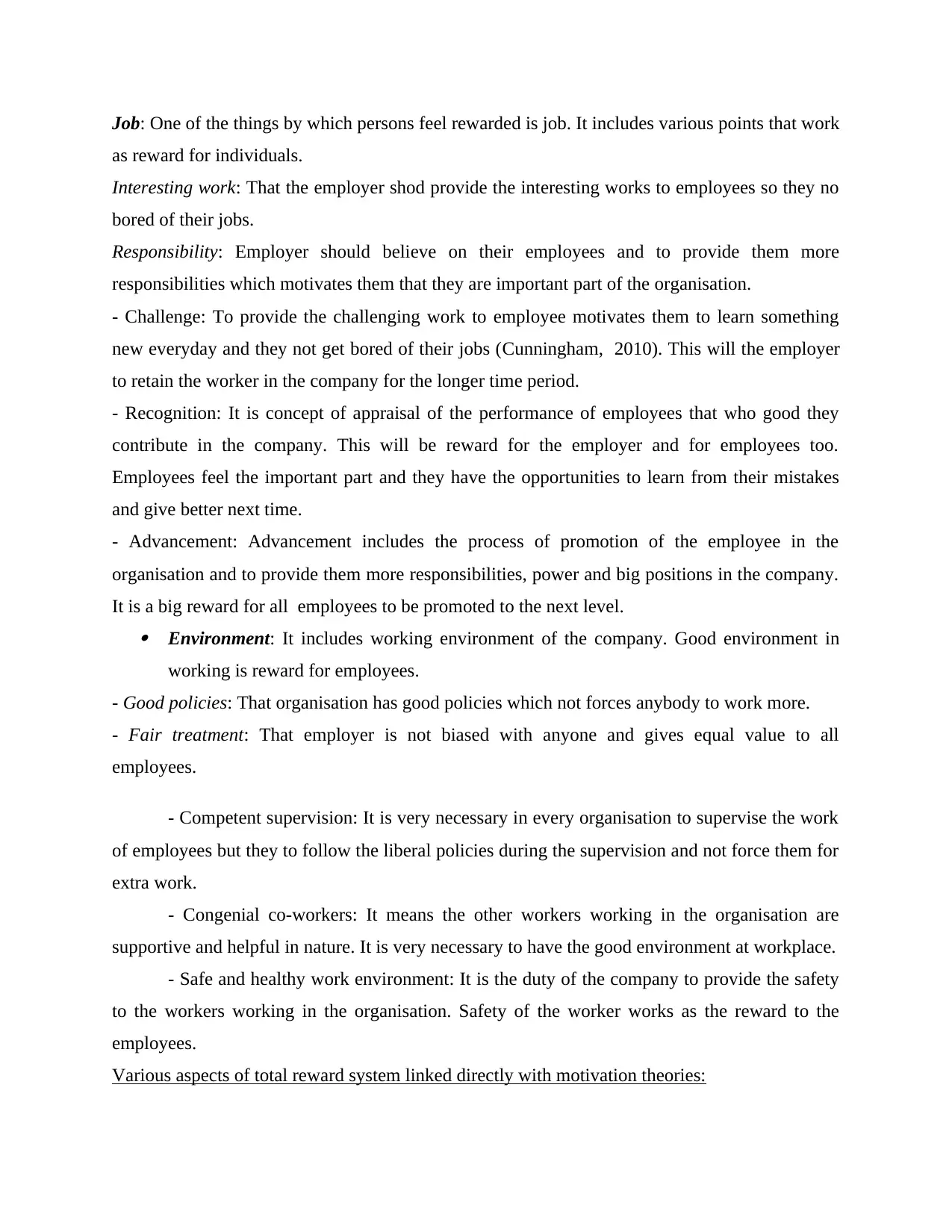
Job: One of the things by which persons feel rewarded is job. It includes various points that work
as reward for individuals.
Interesting work: That the employer shod provide the interesting works to employees so they no
bored of their jobs.
Responsibility: Employer should believe on their employees and to provide them more
responsibilities which motivates them that they are important part of the organisation.
- Challenge: To provide the challenging work to employee motivates them to learn something
new everyday and they not get bored of their jobs (Cunningham, 2010). This will the employer
to retain the worker in the company for the longer time period.
- Recognition: It is concept of appraisal of the performance of employees that who good they
contribute in the company. This will be reward for the employer and for employees too.
Employees feel the important part and they have the opportunities to learn from their mistakes
and give better next time.
- Advancement: Advancement includes the process of promotion of the employee in the
organisation and to provide them more responsibilities, power and big positions in the company.
It is a big reward for all employees to be promoted to the next level. Environment: It includes working environment of the company. Good environment in
working is reward for employees.
- Good policies: That organisation has good policies which not forces anybody to work more.
- Fair treatment: That employer is not biased with anyone and gives equal value to all
employees.
- Competent supervision: It is very necessary in every organisation to supervise the work
of employees but they to follow the liberal policies during the supervision and not force them for
extra work.
- Congenial co-workers: It means the other workers working in the organisation are
supportive and helpful in nature. It is very necessary to have the good environment at workplace.
- Safe and healthy work environment: It is the duty of the company to provide the safety
to the workers working in the organisation. Safety of the worker works as the reward to the
employees.
Various aspects of total reward system linked directly with motivation theories:
as reward for individuals.
Interesting work: That the employer shod provide the interesting works to employees so they no
bored of their jobs.
Responsibility: Employer should believe on their employees and to provide them more
responsibilities which motivates them that they are important part of the organisation.
- Challenge: To provide the challenging work to employee motivates them to learn something
new everyday and they not get bored of their jobs (Cunningham, 2010). This will the employer
to retain the worker in the company for the longer time period.
- Recognition: It is concept of appraisal of the performance of employees that who good they
contribute in the company. This will be reward for the employer and for employees too.
Employees feel the important part and they have the opportunities to learn from their mistakes
and give better next time.
- Advancement: Advancement includes the process of promotion of the employee in the
organisation and to provide them more responsibilities, power and big positions in the company.
It is a big reward for all employees to be promoted to the next level. Environment: It includes working environment of the company. Good environment in
working is reward for employees.
- Good policies: That organisation has good policies which not forces anybody to work more.
- Fair treatment: That employer is not biased with anyone and gives equal value to all
employees.
- Competent supervision: It is very necessary in every organisation to supervise the work
of employees but they to follow the liberal policies during the supervision and not force them for
extra work.
- Congenial co-workers: It means the other workers working in the organisation are
supportive and helpful in nature. It is very necessary to have the good environment at workplace.
- Safe and healthy work environment: It is the duty of the company to provide the safety
to the workers working in the organisation. Safety of the worker works as the reward to the
employees.
Various aspects of total reward system linked directly with motivation theories:
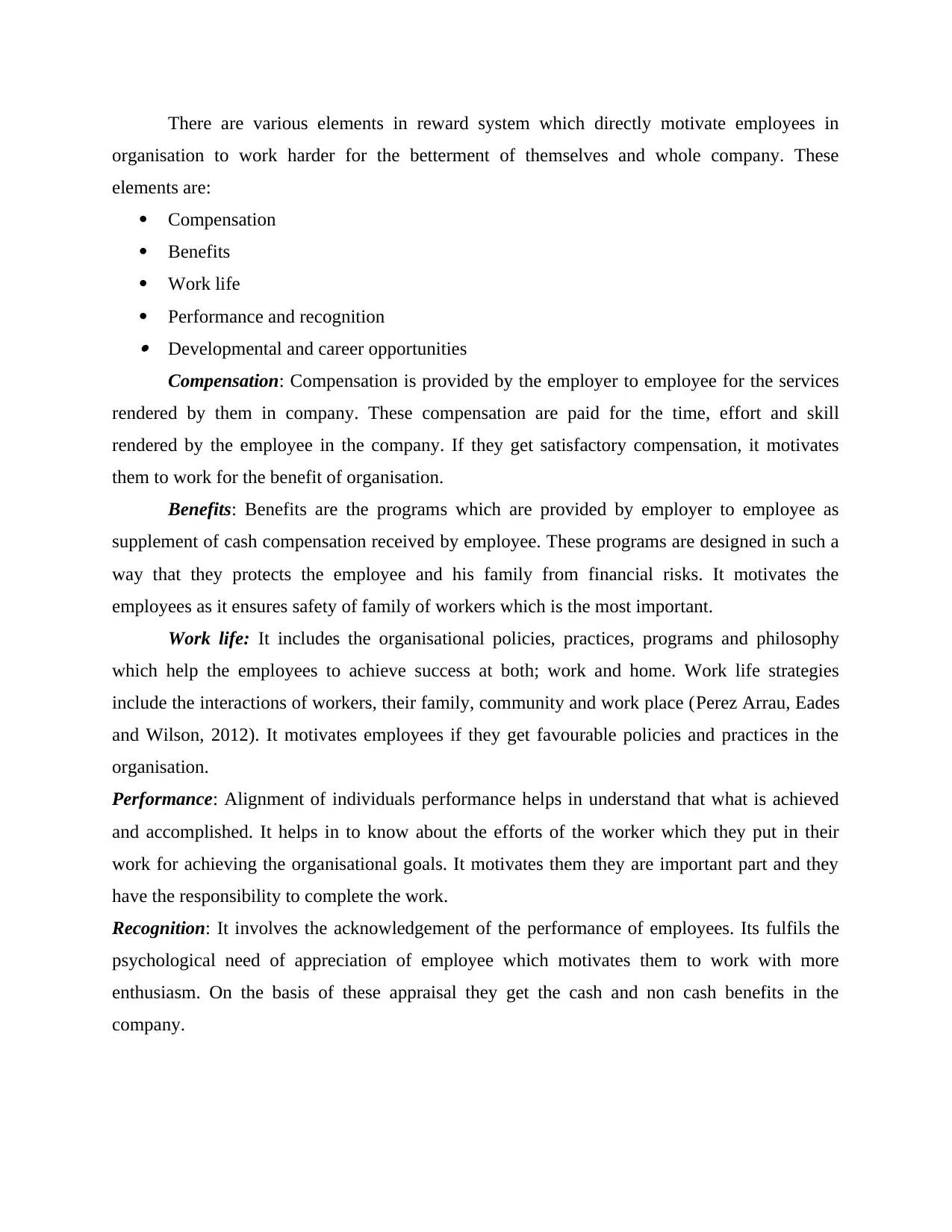
There are various elements in reward system which directly motivate employees in
organisation to work harder for the betterment of themselves and whole company. These
elements are:
Compensation
Benefits
Work life
Performance and recognition Developmental and career opportunities
Compensation: Compensation is provided by the employer to employee for the services
rendered by them in company. These compensation are paid for the time, effort and skill
rendered by the employee in the company. If they get satisfactory compensation, it motivates
them to work for the benefit of organisation.
Benefits: Benefits are the programs which are provided by employer to employee as
supplement of cash compensation received by employee. These programs are designed in such a
way that they protects the employee and his family from financial risks. It motivates the
employees as it ensures safety of family of workers which is the most important.
Work life: It includes the organisational policies, practices, programs and philosophy
which help the employees to achieve success at both; work and home. Work life strategies
include the interactions of workers, their family, community and work place (Perez Arrau, Eades
and Wilson, 2012). It motivates employees if they get favourable policies and practices in the
organisation.
Performance: Alignment of individuals performance helps in understand that what is achieved
and accomplished. It helps in to know about the efforts of the worker which they put in their
work for achieving the organisational goals. It motivates them they are important part and they
have the responsibility to complete the work.
Recognition: It involves the acknowledgement of the performance of employees. Its fulfils the
psychological need of appreciation of employee which motivates them to work with more
enthusiasm. On the basis of these appraisal they get the cash and non cash benefits in the
company.
organisation to work harder for the betterment of themselves and whole company. These
elements are:
Compensation
Benefits
Work life
Performance and recognition Developmental and career opportunities
Compensation: Compensation is provided by the employer to employee for the services
rendered by them in company. These compensation are paid for the time, effort and skill
rendered by the employee in the company. If they get satisfactory compensation, it motivates
them to work for the benefit of organisation.
Benefits: Benefits are the programs which are provided by employer to employee as
supplement of cash compensation received by employee. These programs are designed in such a
way that they protects the employee and his family from financial risks. It motivates the
employees as it ensures safety of family of workers which is the most important.
Work life: It includes the organisational policies, practices, programs and philosophy
which help the employees to achieve success at both; work and home. Work life strategies
include the interactions of workers, their family, community and work place (Perez Arrau, Eades
and Wilson, 2012). It motivates employees if they get favourable policies and practices in the
organisation.
Performance: Alignment of individuals performance helps in understand that what is achieved
and accomplished. It helps in to know about the efforts of the worker which they put in their
work for achieving the organisational goals. It motivates them they are important part and they
have the responsibility to complete the work.
Recognition: It involves the acknowledgement of the performance of employees. Its fulfils the
psychological need of appreciation of employee which motivates them to work with more
enthusiasm. On the basis of these appraisal they get the cash and non cash benefits in the
company.
⊘ This is a preview!⊘
Do you want full access?
Subscribe today to unlock all pages.

Trusted by 1+ million students worldwide
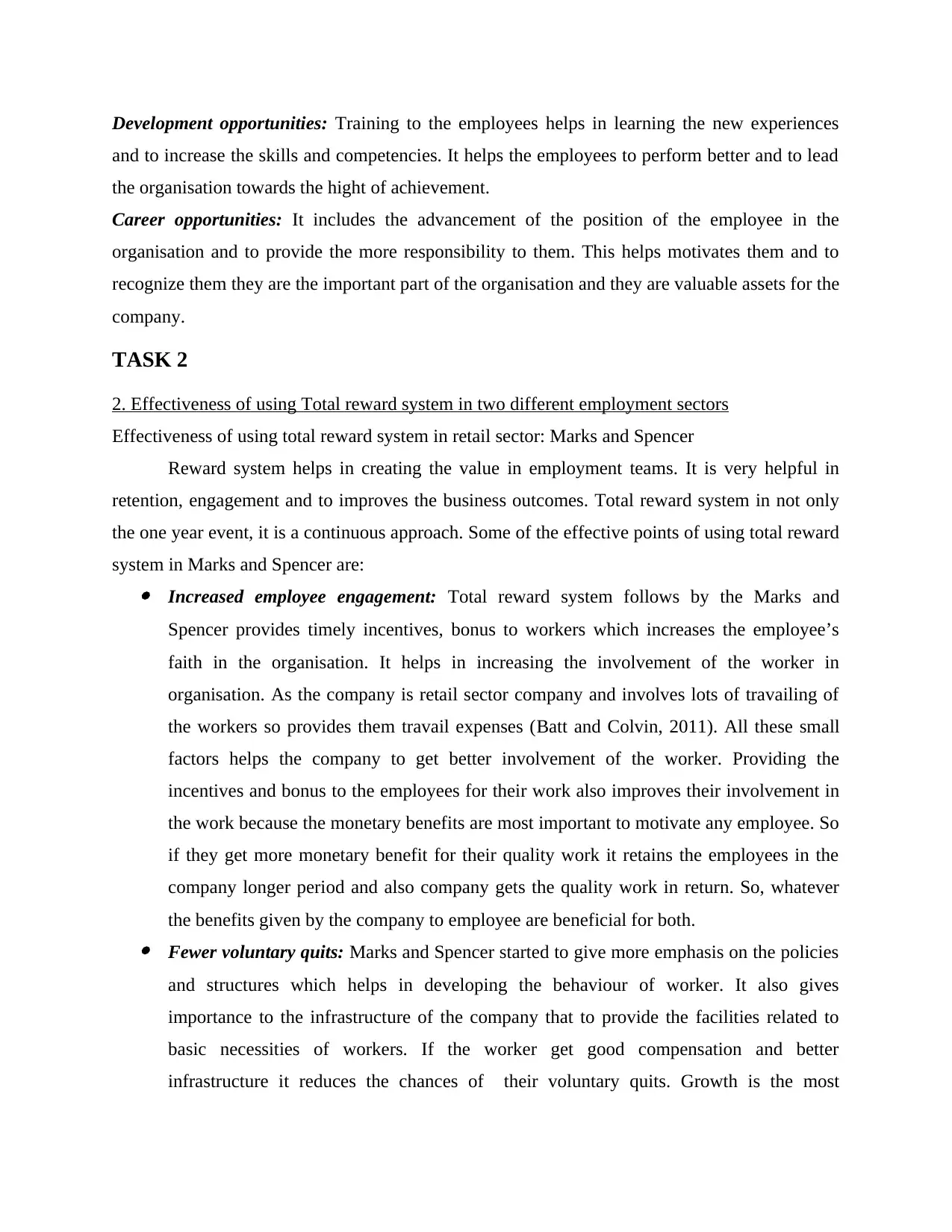
Development opportunities: Training to the employees helps in learning the new experiences
and to increase the skills and competencies. It helps the employees to perform better and to lead
the organisation towards the hight of achievement.
Career opportunities: It includes the advancement of the position of the employee in the
organisation and to provide the more responsibility to them. This helps motivates them and to
recognize them they are the important part of the organisation and they are valuable assets for the
company.
TASK 2
2. Effectiveness of using Total reward system in two different employment sectors
Effectiveness of using total reward system in retail sector: Marks and Spencer
Reward system helps in creating the value in employment teams. It is very helpful in
retention, engagement and to improves the business outcomes. Total reward system in not only
the one year event, it is a continuous approach. Some of the effective points of using total reward
system in Marks and Spencer are: Increased employee engagement: Total reward system follows by the Marks and
Spencer provides timely incentives, bonus to workers which increases the employee’s
faith in the organisation. It helps in increasing the involvement of the worker in
organisation. As the company is retail sector company and involves lots of travailing of
the workers so provides them travail expenses (Batt and Colvin, 2011). All these small
factors helps the company to get better involvement of the worker. Providing the
incentives and bonus to the employees for their work also improves their involvement in
the work because the monetary benefits are most important to motivate any employee. So
if they get more monetary benefit for their quality work it retains the employees in the
company longer period and also company gets the quality work in return. So, whatever
the benefits given by the company to employee are beneficial for both. Fewer voluntary quits: Marks and Spencer started to give more emphasis on the policies
and structures which helps in developing the behaviour of worker. It also gives
importance to the infrastructure of the company that to provide the facilities related to
basic necessities of workers. If the worker get good compensation and better
infrastructure it reduces the chances of their voluntary quits. Growth is the most
and to increase the skills and competencies. It helps the employees to perform better and to lead
the organisation towards the hight of achievement.
Career opportunities: It includes the advancement of the position of the employee in the
organisation and to provide the more responsibility to them. This helps motivates them and to
recognize them they are the important part of the organisation and they are valuable assets for the
company.
TASK 2
2. Effectiveness of using Total reward system in two different employment sectors
Effectiveness of using total reward system in retail sector: Marks and Spencer
Reward system helps in creating the value in employment teams. It is very helpful in
retention, engagement and to improves the business outcomes. Total reward system in not only
the one year event, it is a continuous approach. Some of the effective points of using total reward
system in Marks and Spencer are: Increased employee engagement: Total reward system follows by the Marks and
Spencer provides timely incentives, bonus to workers which increases the employee’s
faith in the organisation. It helps in increasing the involvement of the worker in
organisation. As the company is retail sector company and involves lots of travailing of
the workers so provides them travail expenses (Batt and Colvin, 2011). All these small
factors helps the company to get better involvement of the worker. Providing the
incentives and bonus to the employees for their work also improves their involvement in
the work because the monetary benefits are most important to motivate any employee. So
if they get more monetary benefit for their quality work it retains the employees in the
company longer period and also company gets the quality work in return. So, whatever
the benefits given by the company to employee are beneficial for both. Fewer voluntary quits: Marks and Spencer started to give more emphasis on the policies
and structures which helps in developing the behaviour of worker. It also gives
importance to the infrastructure of the company that to provide the facilities related to
basic necessities of workers. If the worker get good compensation and better
infrastructure it reduces the chances of their voluntary quits. Growth is the most
Paraphrase This Document
Need a fresh take? Get an instant paraphrase of this document with our AI Paraphraser
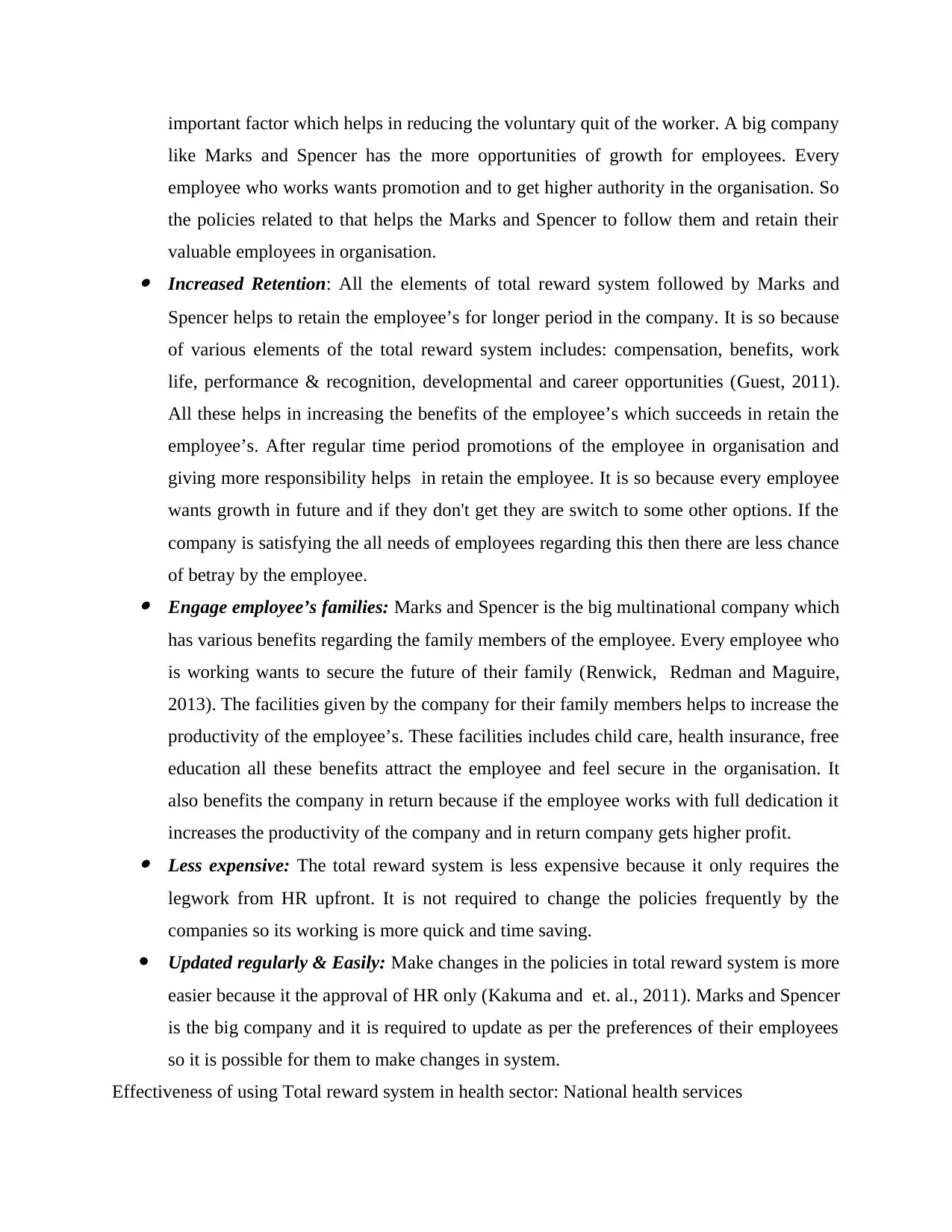
important factor which helps in reducing the voluntary quit of the worker. A big company
like Marks and Spencer has the more opportunities of growth for employees. Every
employee who works wants promotion and to get higher authority in the organisation. So
the policies related to that helps the Marks and Spencer to follow them and retain their
valuable employees in organisation. Increased Retention: All the elements of total reward system followed by Marks and
Spencer helps to retain the employee’s for longer period in the company. It is so because
of various elements of the total reward system includes: compensation, benefits, work
life, performance & recognition, developmental and career opportunities (Guest, 2011).
All these helps in increasing the benefits of the employee’s which succeeds in retain the
employee’s. After regular time period promotions of the employee in organisation and
giving more responsibility helps in retain the employee. It is so because every employee
wants growth in future and if they don't get they are switch to some other options. If the
company is satisfying the all needs of employees regarding this then there are less chance
of betray by the employee. Engage employee’s families: Marks and Spencer is the big multinational company which
has various benefits regarding the family members of the employee. Every employee who
is working wants to secure the future of their family (Renwick, Redman and Maguire,
2013). The facilities given by the company for their family members helps to increase the
productivity of the employee’s. These facilities includes child care, health insurance, free
education all these benefits attract the employee and feel secure in the organisation. It
also benefits the company in return because if the employee works with full dedication it
increases the productivity of the company and in return company gets higher profit. Less expensive: The total reward system is less expensive because it only requires the
legwork from HR upfront. It is not required to change the policies frequently by the
companies so its working is more quick and time saving.
Updated regularly & Easily: Make changes in the policies in total reward system is more
easier because it the approval of HR only (Kakuma and et. al., 2011). Marks and Spencer
is the big company and it is required to update as per the preferences of their employees
so it is possible for them to make changes in system.
Effectiveness of using Total reward system in health sector: National health services
like Marks and Spencer has the more opportunities of growth for employees. Every
employee who works wants promotion and to get higher authority in the organisation. So
the policies related to that helps the Marks and Spencer to follow them and retain their
valuable employees in organisation. Increased Retention: All the elements of total reward system followed by Marks and
Spencer helps to retain the employee’s for longer period in the company. It is so because
of various elements of the total reward system includes: compensation, benefits, work
life, performance & recognition, developmental and career opportunities (Guest, 2011).
All these helps in increasing the benefits of the employee’s which succeeds in retain the
employee’s. After regular time period promotions of the employee in organisation and
giving more responsibility helps in retain the employee. It is so because every employee
wants growth in future and if they don't get they are switch to some other options. If the
company is satisfying the all needs of employees regarding this then there are less chance
of betray by the employee. Engage employee’s families: Marks and Spencer is the big multinational company which
has various benefits regarding the family members of the employee. Every employee who
is working wants to secure the future of their family (Renwick, Redman and Maguire,
2013). The facilities given by the company for their family members helps to increase the
productivity of the employee’s. These facilities includes child care, health insurance, free
education all these benefits attract the employee and feel secure in the organisation. It
also benefits the company in return because if the employee works with full dedication it
increases the productivity of the company and in return company gets higher profit. Less expensive: The total reward system is less expensive because it only requires the
legwork from HR upfront. It is not required to change the policies frequently by the
companies so its working is more quick and time saving.
Updated regularly & Easily: Make changes in the policies in total reward system is more
easier because it the approval of HR only (Kakuma and et. al., 2011). Marks and Spencer
is the big company and it is required to update as per the preferences of their employees
so it is possible for them to make changes in system.
Effectiveness of using Total reward system in health sector: National health services
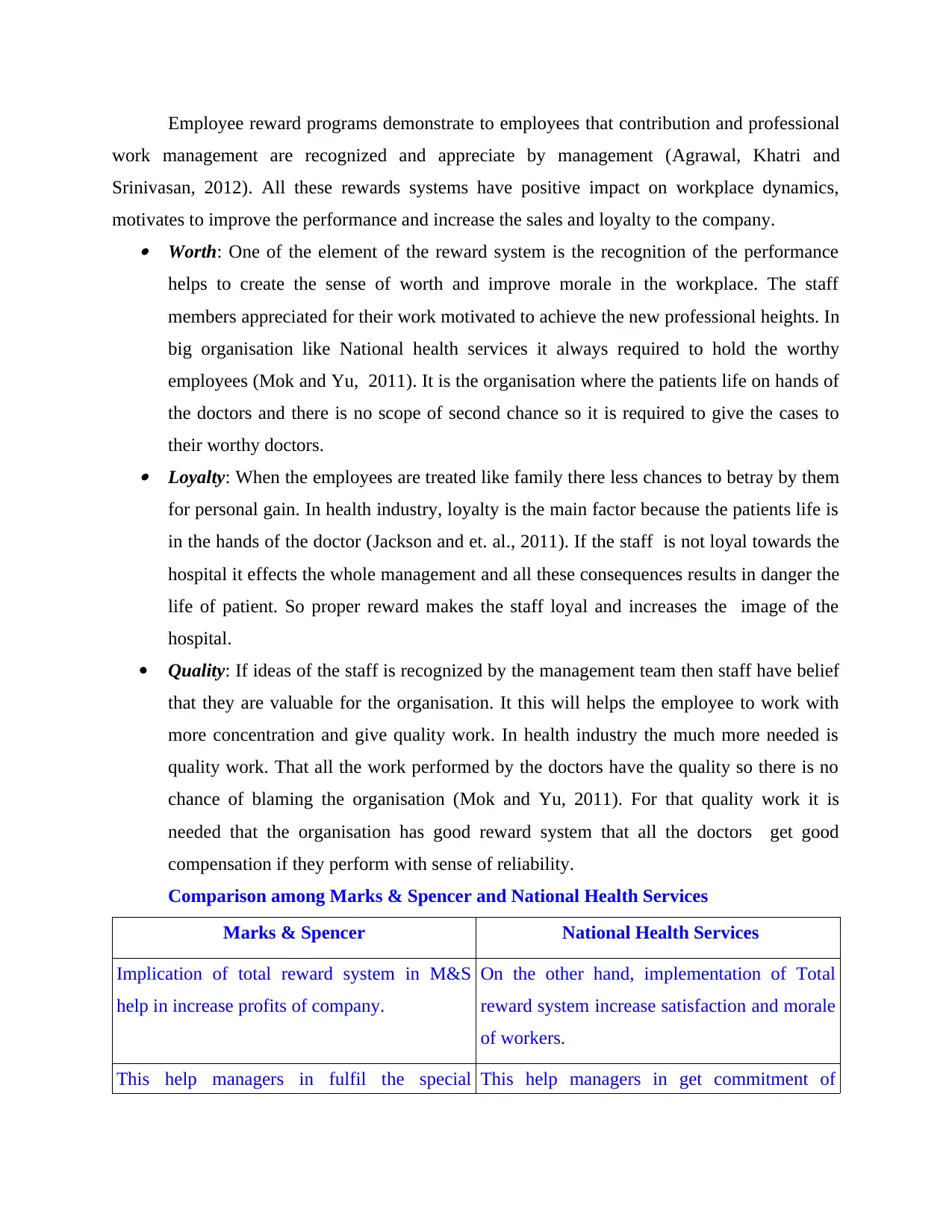
Employee reward programs demonstrate to employees that contribution and professional
work management are recognized and appreciate by management (Agrawal, Khatri and
Srinivasan, 2012). All these rewards systems have positive impact on workplace dynamics,
motivates to improve the performance and increase the sales and loyalty to the company. Worth: One of the element of the reward system is the recognition of the performance
helps to create the sense of worth and improve morale in the workplace. The staff
members appreciated for their work motivated to achieve the new professional heights. In
big organisation like National health services it always required to hold the worthy
employees (Mok and Yu, 2011). It is the organisation where the patients life on hands of
the doctors and there is no scope of second chance so it is required to give the cases to
their worthy doctors. Loyalty: When the employees are treated like family there less chances to betray by them
for personal gain. In health industry, loyalty is the main factor because the patients life is
in the hands of the doctor (Jackson and et. al., 2011). If the staff is not loyal towards the
hospital it effects the whole management and all these consequences results in danger the
life of patient. So proper reward makes the staff loyal and increases the image of the
hospital.
Quality: If ideas of the staff is recognized by the management team then staff have belief
that they are valuable for the organisation. It this will helps the employee to work with
more concentration and give quality work. In health industry the much more needed is
quality work. That all the work performed by the doctors have the quality so there is no
chance of blaming the organisation (Mok and Yu, 2011). For that quality work it is
needed that the organisation has good reward system that all the doctors get good
compensation if they perform with sense of reliability.
Comparison among Marks & Spencer and National Health Services
Marks & Spencer National Health Services
Implication of total reward system in M&S
help in increase profits of company.
On the other hand, implementation of Total
reward system increase satisfaction and morale
of workers.
This help managers in fulfil the special This help managers in get commitment of
work management are recognized and appreciate by management (Agrawal, Khatri and
Srinivasan, 2012). All these rewards systems have positive impact on workplace dynamics,
motivates to improve the performance and increase the sales and loyalty to the company. Worth: One of the element of the reward system is the recognition of the performance
helps to create the sense of worth and improve morale in the workplace. The staff
members appreciated for their work motivated to achieve the new professional heights. In
big organisation like National health services it always required to hold the worthy
employees (Mok and Yu, 2011). It is the organisation where the patients life on hands of
the doctors and there is no scope of second chance so it is required to give the cases to
their worthy doctors. Loyalty: When the employees are treated like family there less chances to betray by them
for personal gain. In health industry, loyalty is the main factor because the patients life is
in the hands of the doctor (Jackson and et. al., 2011). If the staff is not loyal towards the
hospital it effects the whole management and all these consequences results in danger the
life of patient. So proper reward makes the staff loyal and increases the image of the
hospital.
Quality: If ideas of the staff is recognized by the management team then staff have belief
that they are valuable for the organisation. It this will helps the employee to work with
more concentration and give quality work. In health industry the much more needed is
quality work. That all the work performed by the doctors have the quality so there is no
chance of blaming the organisation (Mok and Yu, 2011). For that quality work it is
needed that the organisation has good reward system that all the doctors get good
compensation if they perform with sense of reliability.
Comparison among Marks & Spencer and National Health Services
Marks & Spencer National Health Services
Implication of total reward system in M&S
help in increase profits of company.
On the other hand, implementation of Total
reward system increase satisfaction and morale
of workers.
This help managers in fulfil the special This help managers in get commitment of
⊘ This is a preview!⊘
Do you want full access?
Subscribe today to unlock all pages.

Trusted by 1+ million students worldwide
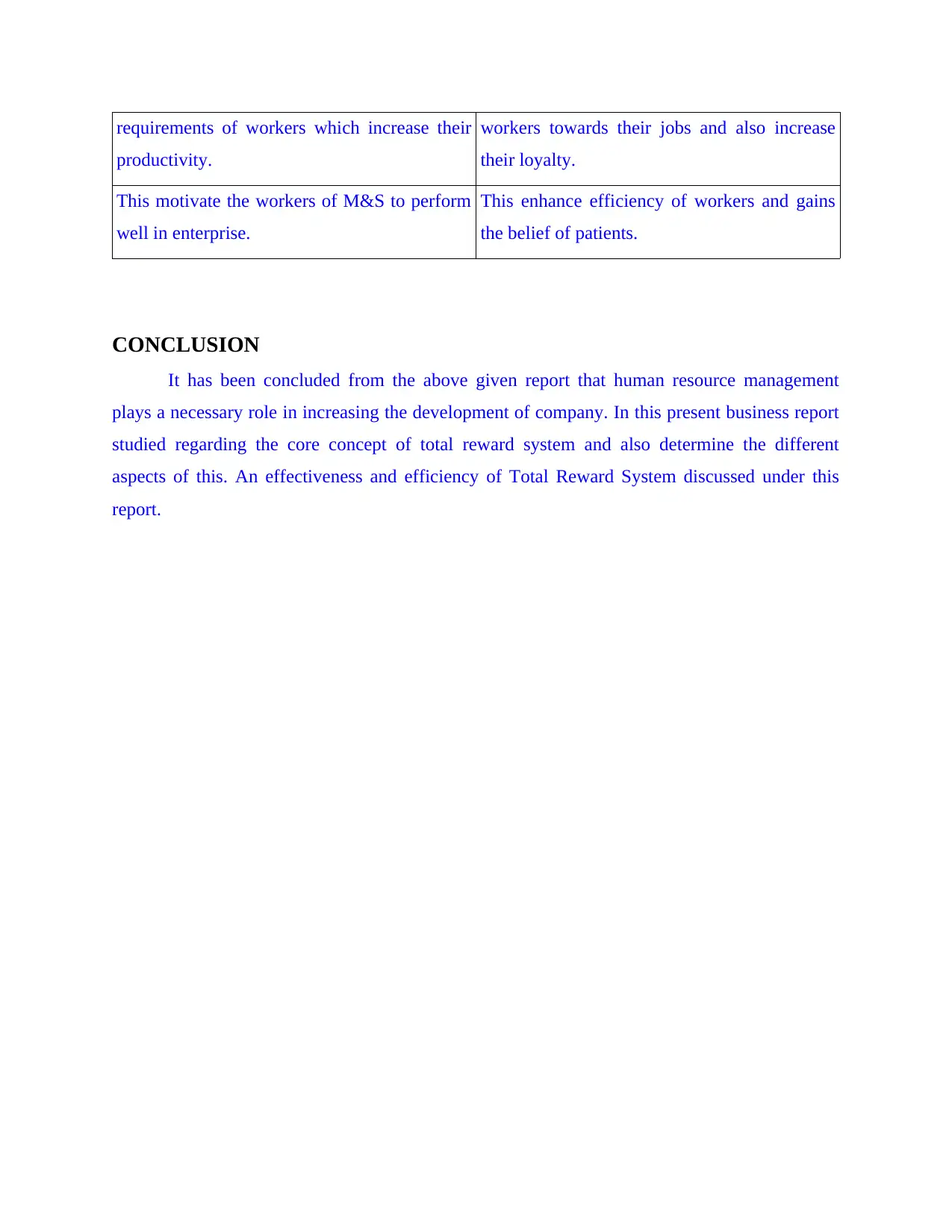
requirements of workers which increase their
productivity.
workers towards their jobs and also increase
their loyalty.
This motivate the workers of M&S to perform
well in enterprise.
This enhance efficiency of workers and gains
the belief of patients.
CONCLUSION
It has been concluded from the above given report that human resource management
plays a necessary role in increasing the development of company. In this present business report
studied regarding the core concept of total reward system and also determine the different
aspects of this. An effectiveness and efficiency of Total Reward System discussed under this
report.
productivity.
workers towards their jobs and also increase
their loyalty.
This motivate the workers of M&S to perform
well in enterprise.
This enhance efficiency of workers and gains
the belief of patients.
CONCLUSION
It has been concluded from the above given report that human resource management
plays a necessary role in increasing the development of company. In this present business report
studied regarding the core concept of total reward system and also determine the different
aspects of this. An effectiveness and efficiency of Total Reward System discussed under this
report.
Paraphrase This Document
Need a fresh take? Get an instant paraphrase of this document with our AI Paraphraser
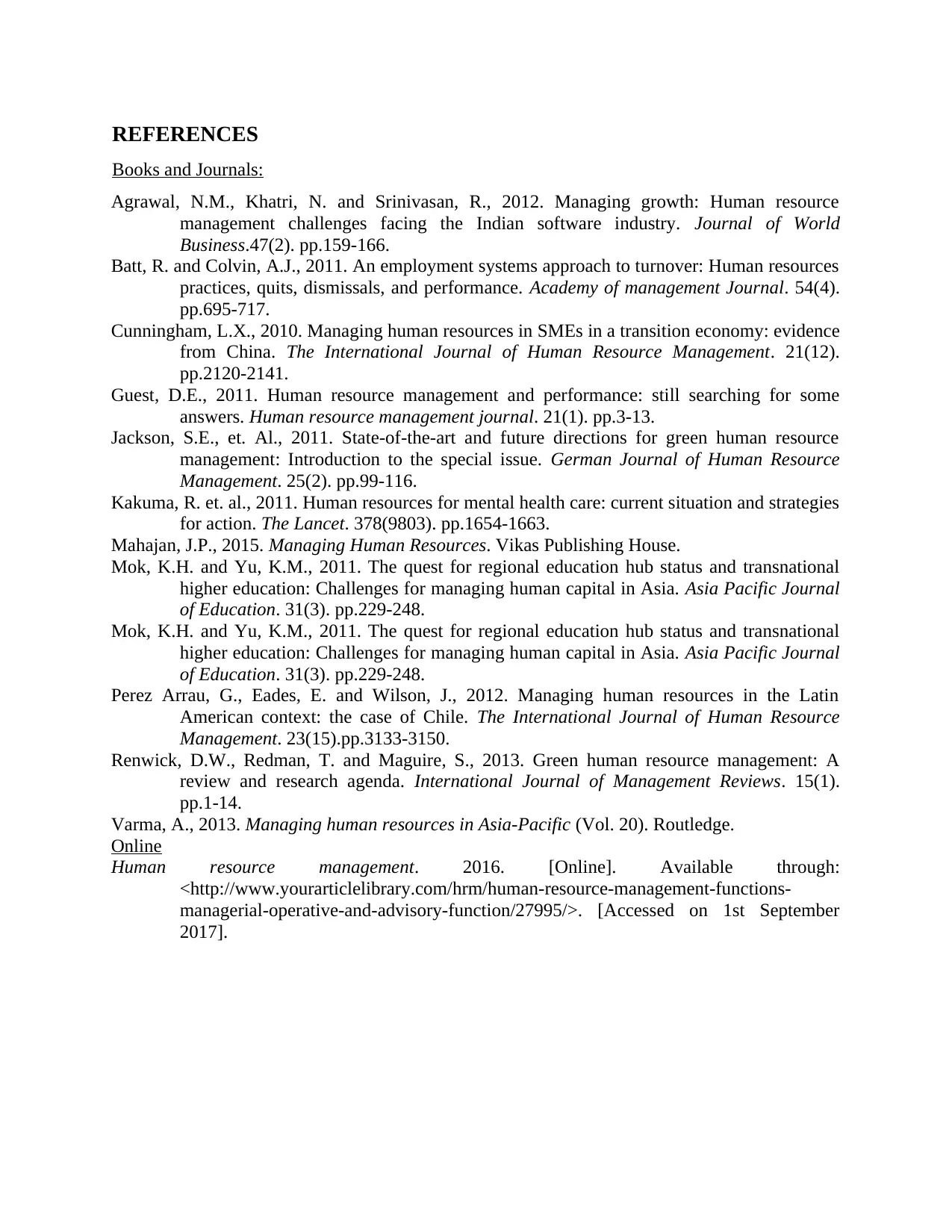
REFERENCES
Books and Journals:
Agrawal, N.M., Khatri, N. and Srinivasan, R., 2012. Managing growth: Human resource
management challenges facing the Indian software industry. Journal of World
Business.47(2). pp.159-166.
Batt, R. and Colvin, A.J., 2011. An employment systems approach to turnover: Human resources
practices, quits, dismissals, and performance. Academy of management Journal. 54(4).
pp.695-717.
Cunningham, L.X., 2010. Managing human resources in SMEs in a transition economy: evidence
from China. The International Journal of Human Resource Management. 21(12).
pp.2120-2141.
Guest, D.E., 2011. Human resource management and performance: still searching for some
answers. Human resource management journal. 21(1). pp.3-13.
Jackson, S.E., et. Al., 2011. State-of-the-art and future directions for green human resource
management: Introduction to the special issue. German Journal of Human Resource
Management. 25(2). pp.99-116.
Kakuma, R. et. al., 2011. Human resources for mental health care: current situation and strategies
for action. The Lancet. 378(9803). pp.1654-1663.
Mahajan, J.P., 2015. Managing Human Resources. Vikas Publishing House.
Mok, K.H. and Yu, K.M., 2011. The quest for regional education hub status and transnational
higher education: Challenges for managing human capital in Asia. Asia Pacific Journal
of Education. 31(3). pp.229-248.
Mok, K.H. and Yu, K.M., 2011. The quest for regional education hub status and transnational
higher education: Challenges for managing human capital in Asia. Asia Pacific Journal
of Education. 31(3). pp.229-248.
Perez Arrau, G., Eades, E. and Wilson, J., 2012. Managing human resources in the Latin
American context: the case of Chile. The International Journal of Human Resource
Management. 23(15).pp.3133-3150.
Renwick, D.W., Redman, T. and Maguire, S., 2013. Green human resource management: A
review and research agenda. International Journal of Management Reviews. 15(1).
pp.1-14.
Varma, A., 2013. Managing human resources in Asia-Pacific (Vol. 20). Routledge.
Online
Human resource management. 2016. [Online]. Available through:
<http://www.yourarticlelibrary.com/hrm/human-resource-management-functions-
managerial-operative-and-advisory-function/27995/>. [Accessed on 1st September
2017].
Books and Journals:
Agrawal, N.M., Khatri, N. and Srinivasan, R., 2012. Managing growth: Human resource
management challenges facing the Indian software industry. Journal of World
Business.47(2). pp.159-166.
Batt, R. and Colvin, A.J., 2011. An employment systems approach to turnover: Human resources
practices, quits, dismissals, and performance. Academy of management Journal. 54(4).
pp.695-717.
Cunningham, L.X., 2010. Managing human resources in SMEs in a transition economy: evidence
from China. The International Journal of Human Resource Management. 21(12).
pp.2120-2141.
Guest, D.E., 2011. Human resource management and performance: still searching for some
answers. Human resource management journal. 21(1). pp.3-13.
Jackson, S.E., et. Al., 2011. State-of-the-art and future directions for green human resource
management: Introduction to the special issue. German Journal of Human Resource
Management. 25(2). pp.99-116.
Kakuma, R. et. al., 2011. Human resources for mental health care: current situation and strategies
for action. The Lancet. 378(9803). pp.1654-1663.
Mahajan, J.P., 2015. Managing Human Resources. Vikas Publishing House.
Mok, K.H. and Yu, K.M., 2011. The quest for regional education hub status and transnational
higher education: Challenges for managing human capital in Asia. Asia Pacific Journal
of Education. 31(3). pp.229-248.
Mok, K.H. and Yu, K.M., 2011. The quest for regional education hub status and transnational
higher education: Challenges for managing human capital in Asia. Asia Pacific Journal
of Education. 31(3). pp.229-248.
Perez Arrau, G., Eades, E. and Wilson, J., 2012. Managing human resources in the Latin
American context: the case of Chile. The International Journal of Human Resource
Management. 23(15).pp.3133-3150.
Renwick, D.W., Redman, T. and Maguire, S., 2013. Green human resource management: A
review and research agenda. International Journal of Management Reviews. 15(1).
pp.1-14.
Varma, A., 2013. Managing human resources in Asia-Pacific (Vol. 20). Routledge.
Online
Human resource management. 2016. [Online]. Available through:
<http://www.yourarticlelibrary.com/hrm/human-resource-management-functions-
managerial-operative-and-advisory-function/27995/>. [Accessed on 1st September
2017].
1 out of 11
Related Documents
Your All-in-One AI-Powered Toolkit for Academic Success.
+13062052269
info@desklib.com
Available 24*7 on WhatsApp / Email
![[object Object]](/_next/static/media/star-bottom.7253800d.svg)
Unlock your academic potential
Copyright © 2020–2025 A2Z Services. All Rights Reserved. Developed and managed by ZUCOL.





